traction control RENAULT KANGOO 2012 X61 / 2.G Owners Manual
[x] Cancel search | Manufacturer: RENAULT, Model Year: 2012, Model line: KANGOO, Model: RENAULT KANGOO 2012 X61 / 2.GPages: 237, PDF Size: 8.62 MB
Page 60 of 237
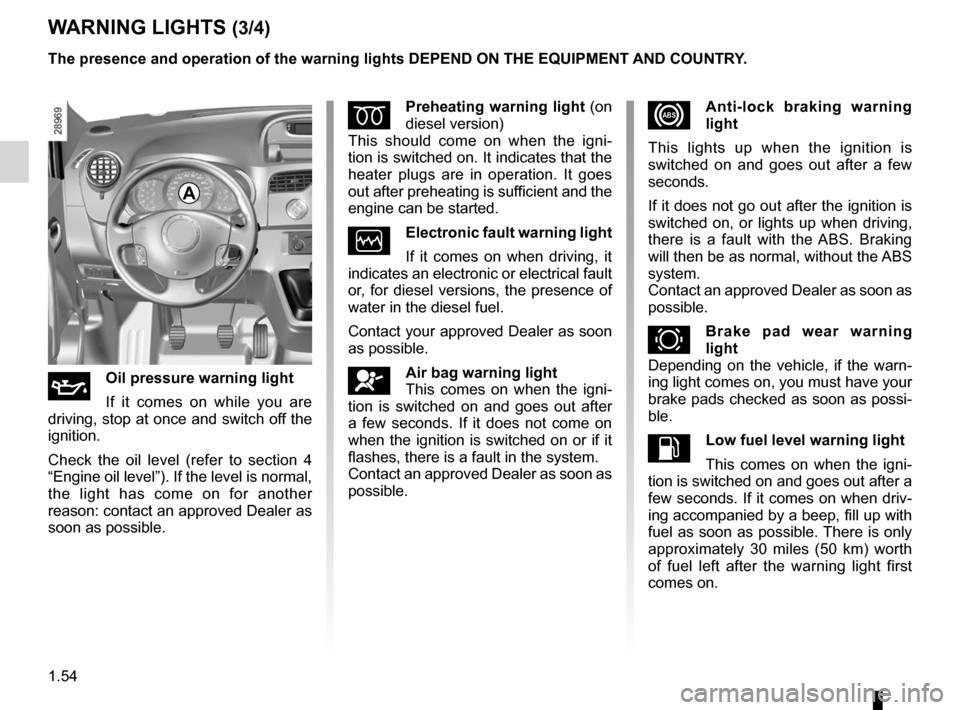
engine oil ............................................................... (current page)
battery .................................................................... (current page)
speed limiter .......................................................... (current page)
cruise control ......................................................... (current page)
ASR (traction control) ............................................ (current page)
filter particle filter ..................................................... (current page)
ESP: Electronic Stability Program ........ (up to the end of the DU)
1.54
ENG_UD24365_6
Tableau de bord : témoins lumineux (X61 - F61 - K61 - Renault)
ENG_NU_813-11_FK61_Renault_1
Jaune NoirNoir texte
WARNING LIGHTS (3/4)
A
The presence and operation of the warning lights DepeND ON THe eQUIpMeNT AND COUNTR y.
xAnti-lock braking warning
light
This lights up when the ignition is
switched on and goes out after a few
seconds.
If it does not go out after the ignition is
switched on, or lights up when driving,
there is a fault with the ABS. Braking
will then be as normal, without the ABS
system.
Contact an approved Dealer as soon as
possible.
\b Brake pad wear warning
light
Depending on the vehicle, if the warn-
ing light comes on, you must have your
brake pads checked as soon as possi-
ble.
LLow fuel level warning light
This comes on when the igni -
tion is switched on and goes out after a
few seconds. If it comes on when driv-
ing accompanied by a beep, fill up with
fuel as soon as possible. There is only
approximately 30 miles (50 km) worth
of fuel left after the warning light first
comes on.
Épreheating warning light (on
diesel version)
This should come on when the igni -
tion is switched on. It indicates that the
heater plugs are in operation. It goes
out after preheating is sufficient and the
engine can be started.
Òelectronic fault warning light
If it comes on when driving, it
indicates an electronic or electrical fault
or, for diesel versions, the presence of
water in the diesel fuel.
Contact your approved Dealer as soon
as possible.
åAir bag warning light
This comes on when the igni -
tion is switched on and goes out after
a few seconds. If it does not come on
when the ignition is switched on or if it
flashes, there is a fault in the system.
Contact an approved Dealer as soon as
possible.
ÀOil pressure warning light
If it comes on while you are
driving, stop at once and switch off the
ignition.
Check the oil level (refer to section 4
“Engine oil level”). If the level is normal,
the light has come on for another
reason: contact an approved Dealer as
soon as possible.
Page 72 of 237
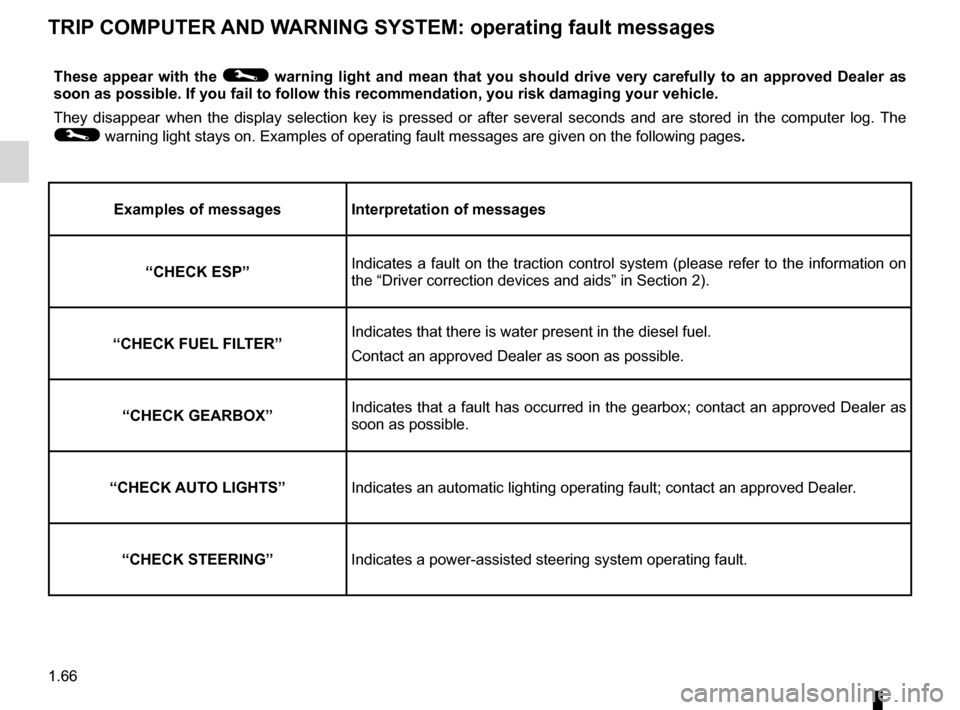
trip computer and warning system.........................(current page)
instrument panel messages ...................................(current page)
warning lights ......................................................... (current page)
instrument panel .................................................... (current page)
1.66
ENG_UD26591_3
Ordinateur de bord : messages d’anomalies de fonctionnement (X85 - X61 - F61 - K61 - Renault)
ENG_NU_813-11_FK61_Renault_1
These appear with the © warning light and mean that you should drive very carefully to an approved Dealer as
soon as possible. If you fail to follow this recommendation, you risk damaging your vehicle.
They disappear when the display selection key is pressed or after several seconds and are stored in the computer log. The
© warning light stays on. Examples of operating fault messages are given on the following pages .
examples of messages Interpretation of messages
“CHeCK eSp” Indicates a fault on the traction control system (please refer to the information on
the “Driver correction devices and aids” in Section 2).
“CHeCK FUeL FILTeR” Indicates that there is water present in the diesel fuel.
Contact an approved Dealer as soon as possible.
“CHeCK GeARBOX ”Indicates that a fault has occurred in the gearbox; contact an approved Dealer as
soon as possible.
“CHeCK AUTO LIGHTS ”Indicates an automatic lighting operating fault; contact an approved Dealer .
“CHeCK STeeRING” Indicates a power-assisted steering system operating fault.
TRIp COMpUTeR AND WARNING SySTeM: operating fault messages
Page 101 of 237
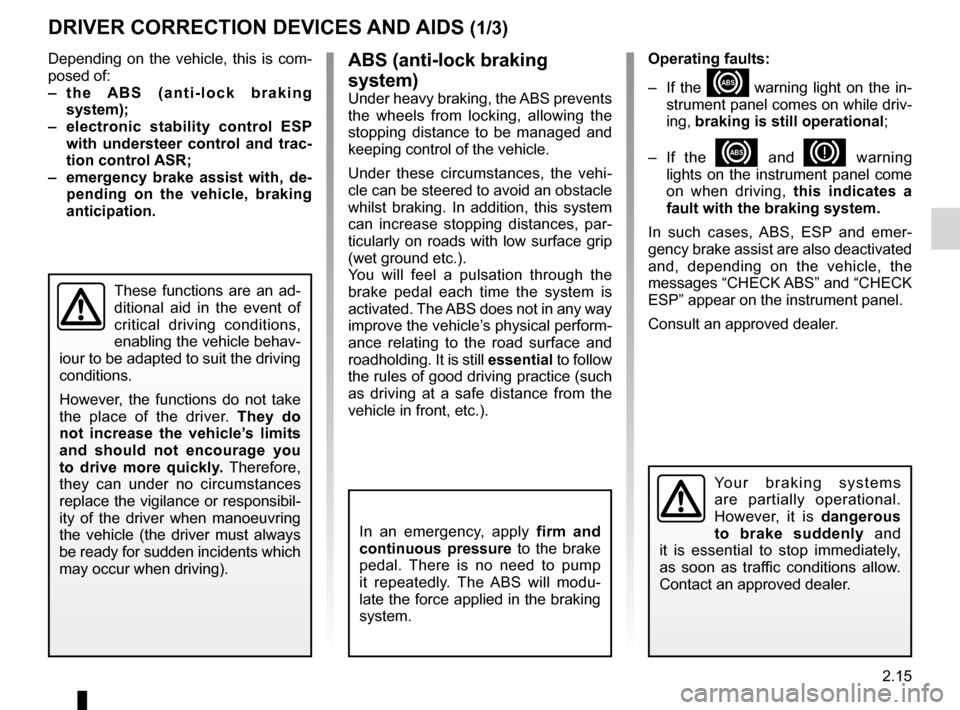
ASR (traction control) ........................... (up to the end of the DU)
ABS ...................................................... (up to the end of the DU)
traction control: ASR .............................(up to the end of the DU)
driving ................................................... (up to the end of the DU)
traction control: ASR .............................(up to the end of the DU)
anti-lock braking system: ABS ..............(up to the end of the DU)
ESP: Electronic Stability Program ........ (up to the end of the DU)
emergency brake assist ........................(up to the end of the DU)
emergency braking ............................... (up to the end of the DU)
Electronic Stability Program: ESP ........ (up to the end of the DU)
2.15
ENG_UD29758_3
Dispositifs de correction de conduite (X61 - F61 - K61 - Renault)
ENG_NU_813-11_FK61_Renault_2
AbS (anti-lock braking
system)
Under heavy braking, the ABS prevents
the wheels from locking, allowing the
stopping distance to be managed and
keeping control of the vehicle.
Under these circumstances, the vehi -
cle can be steered to avoid an obstacle
whilst braking. In addition, this system
can increase stopping distances, par -
ticularly on roads with low surface grip
(wet ground etc.).
You will feel a pulsation through the
brake pedal each time the system is
activated. The ABS does not in any way
improve the vehicle’s physical perform-
ance relating to the road surface and
roadholding. It is still essential to follow
the rules of good driving practice (such
as driving at a safe distance from the
vehicle in front, etc.).
Driver correction devices and aids
Operating faults:
– If the
x warning light on the in-
strument panel comes on while driv-
ing, braking is still operational ;
– If the
x and D warning
lights on the instrument panel come
on when driving, this indicates a
fault with the braking system.
In such cases, ABS, ESP and emer -
gency brake assist are also deactivated
and, depending on the vehicle, the
messages “CHECK ABS” and “CHECK
ESP” appear on the instrument panel.
Consult an approved dealer.
DRIVER CORRECTION DEVICES AND AIDS (1/3)
In an emergency, apply firm and
continuous pressure to the brake
pedal. There is no need to pump
it repeatedly. The ABS will modu -
late the force applied in the braking
system.
These functions are an ad-
ditional aid in the event of
critical driving conditions,
enabling the vehicle behav -
iour to be adapted to suit the driving
conditions.
However, the functions do not take
the place of the driver. They do
not increase the vehicle’s limits
and should not encourage you
to drive more quickly. Therefore,
they can under no circumstances
replace the vigilance or responsibil -
ity of the driver when manoeuvring
the vehicle (the driver must always
be ready for sudden incidents which
may occur when driving).
Yo u r b r a k i n g s y s t e m s
are partially operational.
However, it is dangerous
to brake suddenly and
it is essential to stop immediately,
as soon as traffic conditions allow.
Contact an approved dealer.
Depending on the vehicle, this is com-
posed of:
– t h e A bS ( a n t i - l o c k b r a k i n g
system);
– electronic stability control ESP
with understeer control and trac -
tion control ASR;
– emergency brake assist with, de -
pending on the vehicle, braking
anticipation.
Page 102 of 237
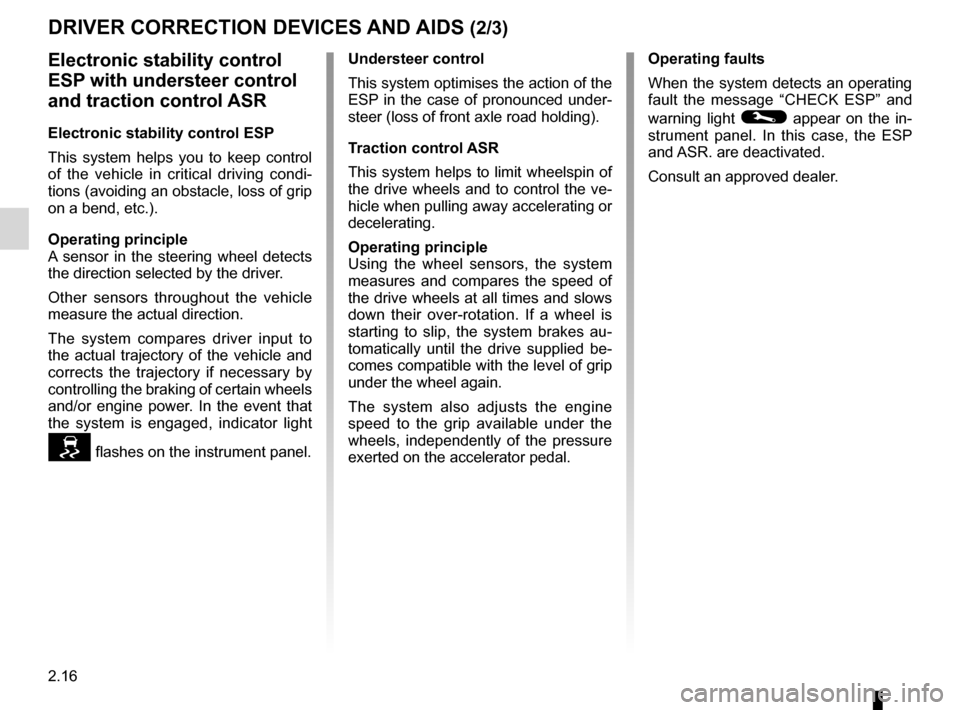
2.16
ENG_UD29758_3
Dispositifs de correction de conduite (X61 - F61 - K61 - Renault)
ENG_NU_813-11_FK61_Renault_2
Jaune NoirNoir texte
DRIVER CORRECTION DEVICES AND AIDS (2/3)
Electronic stability control
ESP with understeer control
and traction control ASR
Electronic stability control ESP
This system helps you to keep control
of the vehicle in critical driving condi -
tions (avoiding an obstacle, loss of grip
on a bend, etc.).
Operating principle
A sensor in the steering wheel detects
the direction selected by the driver.
Other sensors throughout the vehicle
measure the actual direction.
The system compares driver input to
the actual trajectory of the vehicle and
corrects the trajectory if necessary by
controlling the braking of certain wheels
and/or engine power. In the event that
the system is engaged, indicator light
flashes on the instrument panel. Understeer control
This system optimises the action of the
ESP in the case of pronounced under
-
steer (loss of front axle road holding).
Traction control ASR
This system helps to limit wheelspin of
the drive wheels and to control the ve-
hicle when pulling away accelerating or
decelerating.
Operating principle
Using the wheel sensors, the system
measures and compares the speed of
the drive wheels at all times and slows
down their over-rotation. If a wheel is
starting to slip, the system brakes au -
tomatically until the drive supplied be -
comes compatible with the level of grip
under the wheel again.
The system also adjusts the engine
speed to the grip available under the
wheels, independently of the pressure
exerted on the accelerator pedal. Operating faults
When the system detects an operating
fault the message “
CHECK ESP” and
warning light
© appear on the in-
strument panel. In this case, the ESP
and ASR. are deactivated.
Consult an approved dealer.
Page 103 of 237
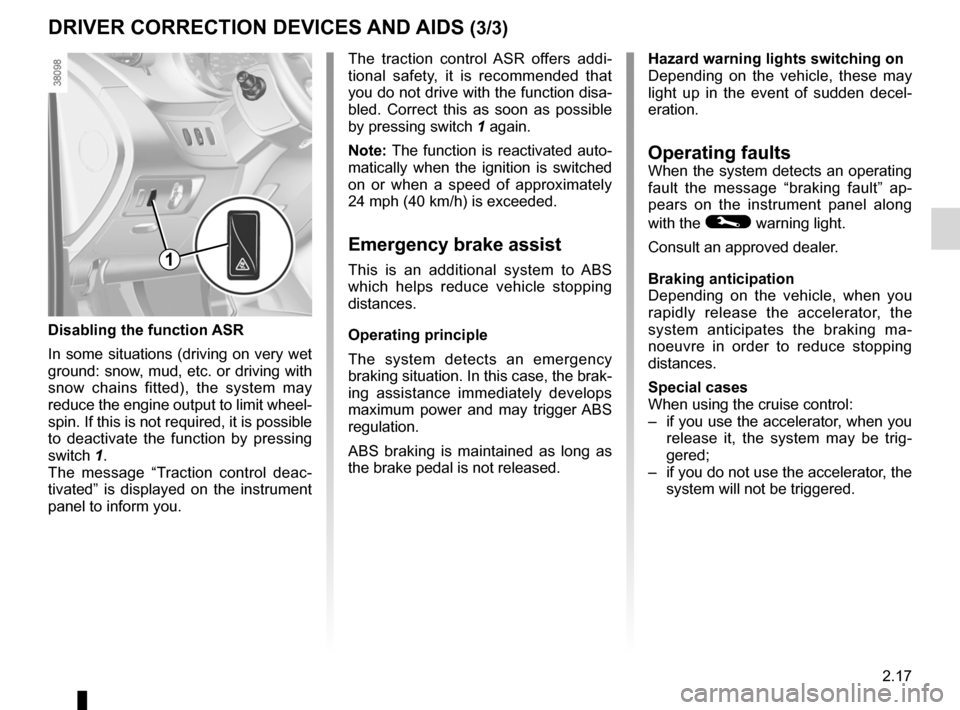
JauneNoirNoir texte
2.17
ENG_UD29758_3
Dispositifs de correction de conduite (X61 - F61 - K61 - Renault)
ENG_NU_813-11_FK61_Renault_2
Disabling the function ASR
In some situations (driving on very wet
ground: snow, mud, etc. or driving with
snow chains fitted), the system may
reduce the engine output to limit wheel -
spin. If this is not required, it is possible
to deactivate the function by pressing
switch 1.
The message “Traction control deac -
tivated” is displayed on the instrument
panel to inform you. The traction control ASR offers addi
-
tional safety, it is recommended that
you do not drive with the function disa-
bled. Correct this as soon as possible
by pressing switch 1 again.
Note: The function is reactivated auto-
matically when the ignition is switched
on or when a speed of approximately
24 mph (40 km/h) is exceeded.
Emergency brake assist
This is an additional system to ABS
which helps reduce vehicle stopping
distances.
Operating principle
The system detects an emergency
braking situation. In this case, the brak-
ing assistance immediately develops
maximum power and may trigger ABS
regulation.
ABS braking is maintained as long as
the brake pedal is not released.
DRIVER CORRECTION DEVICES AND AIDS (3/3)
Hazard warning lights switching on
Depending on the vehicle, these may
light up in the event of sudden decel -
eration.
Operating faultsWhen the system detects an operating
fault the message “braking fault” ap -
pears on the instrument panel along
with the
© warning light.
Consult an approved dealer.
braking anticipation
Depending on the vehicle, when you
rapidly release the accelerator, the
system anticipates the braking ma -
noeuvre in order to reduce stopping
distances.
Special cases
When using the cruise control:
– if you use the accelerator, when you
release it, the system may be trig -
gered;
– if you do not use the accelerator, the
system will not be triggered.
1
Page 115 of 237
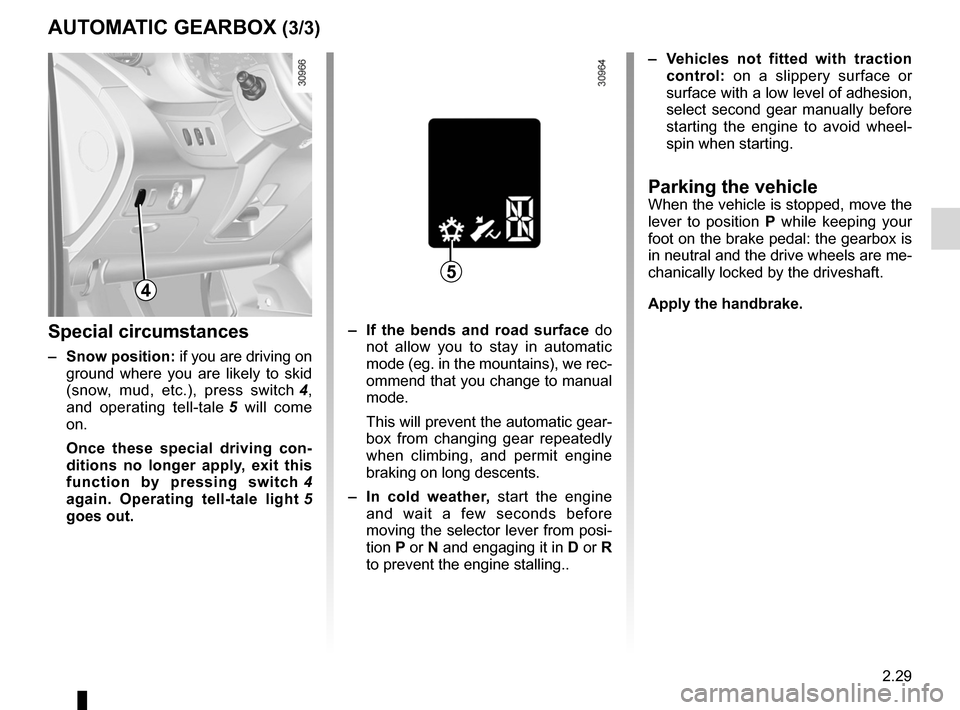
JauneNoirNoir texte
2.29
ENG_UD14843_2
Boîte automatique (X61 - Renault)
ENG_NU_813-11_FK61_Renault_2
AUTOMATIC GEARbOx (3/3)
– Vehicles not fitted with traction
control: on a slippery surface or
surface with a low level of adhesion,
select second gear manually before
starting the engine to avoid wheel -
spin when starting.
Parking the vehicleWhen the vehicle is stopped, move the
lever to position P while keeping your
foot on the brake pedal: the gearbox is
in neutral and the drive wheels are me-
chanically locked by the driveshaft.
Apply the handbrake.
Special circumstances
– Snow position: if you are driving on
ground where you are likely to skid
(snow, mud, etc.), press switch 4 ,
and operating tell-tale 5 will come
on.
Once these special driving con -
ditions no longer apply, exit this
function by pressing switch 4
again. Operating tell-tale light 5
goes out.
4
– If the bends and road surface do
not allow you to stay in automatic
mode (eg. in the mountains), we rec-
ommend that you change to manual
mode.
This will prevent the automatic gear-
box from changing gear repeatedly
when climbing, and permit engine
braking on long descents.
– In cold weather, start the engine
and wait a few seconds before
moving the selector lever from posi-
tion P or N and engaging it in D or R
to prevent the engine stalling..
5
Page 231 of 237
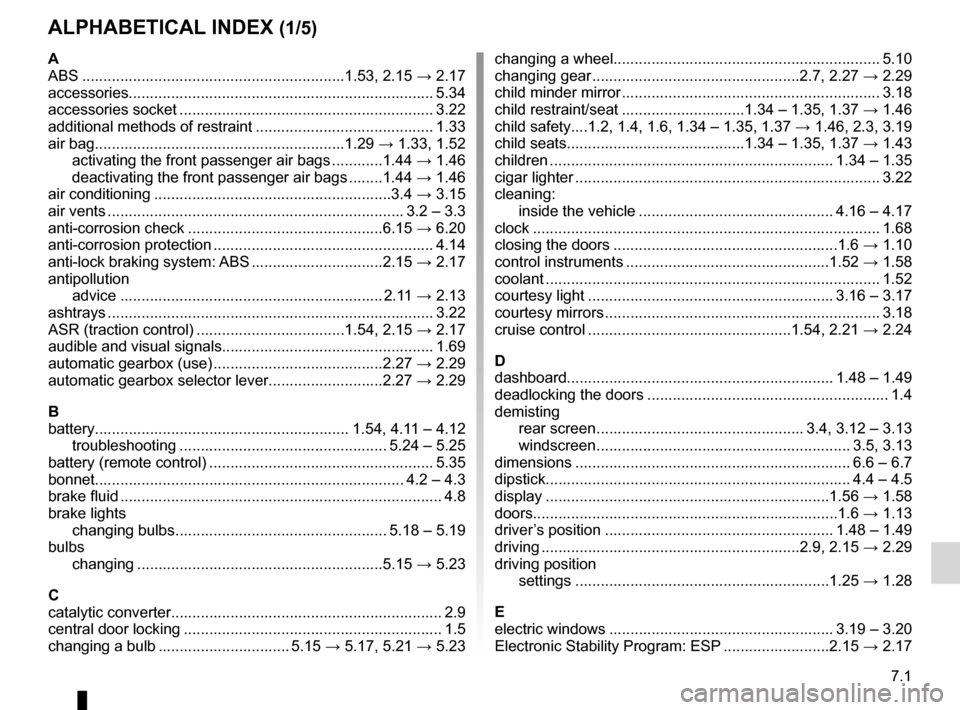
7.1
FRA_UD29767_11
Index (X61 - F61 - K61 - Renault)
ENG_NU_813-11_FK61_Renault_7
AlphAbeticAl index (1/5)
A
ABS .............................................................. 1.53, 2.15 → 2.17
accessories........................................................................ 5.34
accessories socket ............................................................ 3.22
additional methods of restraint .......................................... 1.33
air bag ........................................................... 1.29 → 1.33, 1.52
activating the front passenger air bags ............ 1.44 → 1.46
deactivating the front passenger air bags ........ 1.44 → 1.46
air conditioning ........................................................ 3.4 → 3.15
air vents ...................................................................... 3.2 – 3.3
anti-corrosion check .............................................. 6.15 → 6.20
anti-corrosion protection .................................................... 4.14
anti-lock braking system: ABS ...............................2.15 → 2.17
antipollution advice .............................................................. 2.11 → 2.13
ashtrays ............................................................................. 3.22
ASR (traction control) ................................... 1.54, 2.15 → 2.17
audible and visual signals .................................................. 1.69
automatic gearbox (use) ........................................ 2.27 → 2.29
automatic gearbox selector lever ...........................2.27 → 2.29
b
battery ............................................................ 1.54, 4.11 – 4.12
troubleshooting ................................................. 5.24 – 5.25
battery (remote control) ..................................................... 5.35
bonnet ......................................................................... 4.2 – 4.3
brake fluid ............................................................................ 4.8
brake lights changing bulbs .................................................. 5.18 – 5.19
bulbs changing .......................................................... 5.15 → 5.23
c
catalytic converter ................................................................ 2.9
central door locking ............................................................. 1.5
changing a bulb ............................... 5.15 → 5.17, 5.21 → 5.23 changing a wheel
............................................................... 5.10
changing gear ................................................. 2.7, 2.27 → 2.29
child minder mirror ............................................................. 3.18
child restraint/seat ............................. 1.34 – 1.35, 1.37 → 1.46
child safety ....1.2, 1.4, 1.6, 1.34 – 1.35, 1.37 → 1.46, 2.3, 3.19
child seats .......................................... 1.34 – 1.35, 1.37 → 1.43
children ................................................................... 1.34 – 1.35
cigar lighter ........................................................................ 3.22
cleaning: inside the vehicle .............................................. 4.16 – 4.17
clock .................................................................................. 1.68
closing the doors ..................................................... 1.6 → 1.10
control instruments ................................................ 1.52 → 1.58
coolant ............................................................................... 1.52
courtesy light .......................................................... 3.16 – 3.17
courtesy mirrors ................................................................. 3.18
cruise control ................................................ 1.54, 2.21 → 2.24
d
dashboard ............................................................... 1.48 – 1.49
deadlocking the doors ......................................................... 1.4
demisting rear screen ................................................. 3.4, 3.12 – 3.13
windscreen ............................................................ 3.5, 3.13
dimensions ................................................................. 6.6 – 6.7
dipstick........................................................................ 4.4 – 4.5
display ................................................................... 1.56 → 1.58
doors ........................................................................ 1.6 → 1.13
driver’s position ...................................................... 1.48 – 1.49
driving ............................................................. 2.9, 2.15 → 2.29
driving position settings ............................................................ 1.25 → 1.28
e
electric windows ..................................................... 3.19 – 3.20
Electronic Stability Program: ESP .........................2.15 → 2.17
Page 234 of 237
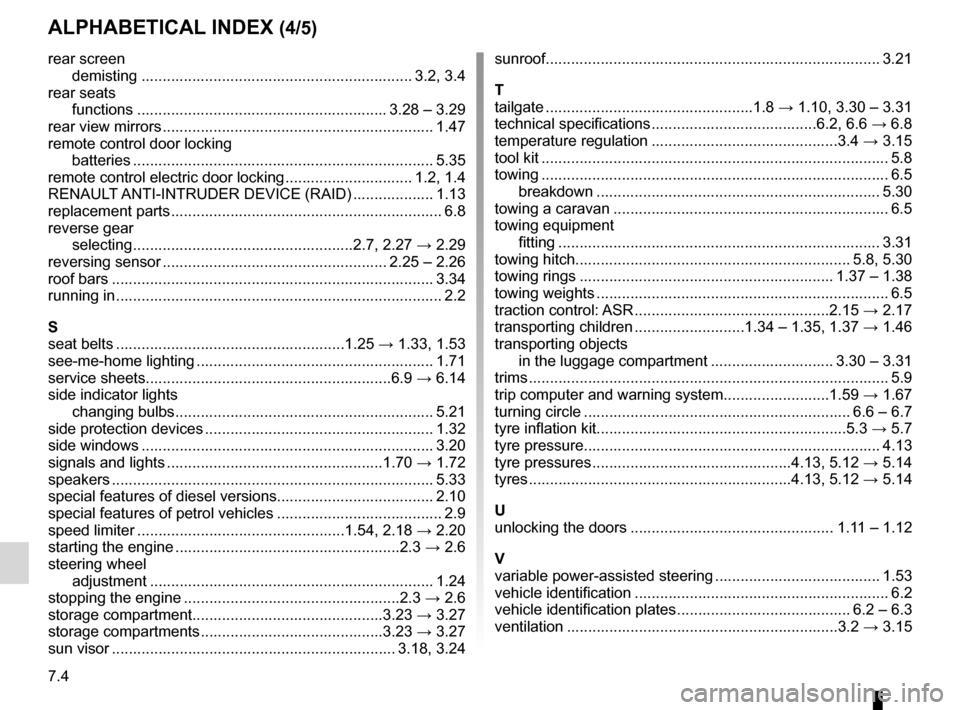
7.4
FRA_UD29767_11
Index (X61 - F61 - K61 - Renault)
ENG_NU_813-11_FK61_Renault_7
Jaune NoirNoir texte
AlphAbeticAl index (4/5)
rear screen
demisting ................................................................ 3.2, 3.4
rear seats functions ........................................................... 3.28 – 3.29
rear view mirrors ................................................................ 1.47
remote control door locking batteries ....................................................................... 5.35
remote control electric door locking .............................. 1.2, 1.4
RENAULT ANTI-INTRUDER DEVICE (RAID) ...................1.13
replacement parts ................................................................ 6.8
reverse gear selecting .................................................... 2.7, 2.27 → 2.29
reversing sensor ..................................................... 2.25 – 2.26
roof bars ............................................................................ 3.34
running in ............................................................................. 2.2
S
seat belts ...................................................... 1.25 → 1.33, 1.53
see-me-home lighting ........................................................ 1.71
service sheets .......................................................... 6.9 → 6.14
side indicator lights changing bulbs ............................................................. 5.21
side protection devices ...................................................... 1.32
side windows ..................................................................... 3.20
signals and lights ................................................... 1.70 → 1.72
speakers ............................................................................ 5.33
special features of diesel versions .....................................2.10
special features of petrol vehicles ....................................... 2.9
speed limiter ................................................. 1.54, 2.18 → 2.20
starting the engine ..................................................... 2.3 → 2.6
steering wheel adjustment ................................................................... 1.24
stopping the engine ................................................... 2.3 → 2.6
storage compartment ............................................. 3.23 → 3.27
storage compartments ........................................... 3.23 → 3.27
sun visor ................................................................... 3.18, 3.24sunroof
............................................................................... 3.21
t
tailgate ................................................. 1.8 → 1.10, 3.30 – 3.31
technical specifications ....................................... 6.2, 6.6 → 6.8
temperature regulation ............................................ 3.4 → 3.15
tool kit .................................................................................. 5.8
towing .................................................................................. 6.5
breakdown ................................................................... 5.30
towing a caravan ................................................................. 6.5
towing equipment fitting ............................................................................ 3.31
towing hitch ................................................................. 5.8, 5.30
towing rings ............................................................ 1.37 – 1.38
towing weights ..................................................................... 6.5
traction control: ASR .............................................. 2.15 → 2.17
transporting children .......................... 1.34 – 1.35, 1.37 → 1.46
transporting objects in the luggage compartment ............................. 3.30 – 3.31
trims ..................................................................................... 5.9
trip computer and warning system .........................1.59 → 1.67
turning circle ............................................................... 6.6 – 6.7
tyre inflation kit ........................................................... 5.3 → 5.7
tyre pressure ...................................................................... 4.13
tyre pressures ............................................... 4.13, 5.12 → 5.14
tyres .............................................................. 4.13, 5.12 → 5.14
U
unlocking the doors ................................................ 1.11 – 1.12
V
variable power-assisted steering ....................................... 1.53
vehicle identification ............................................................ 6.2
vehicle identification plates ......................................... 6.2 – 6.3
ventilation ................................................................ 3.2 → 3.15